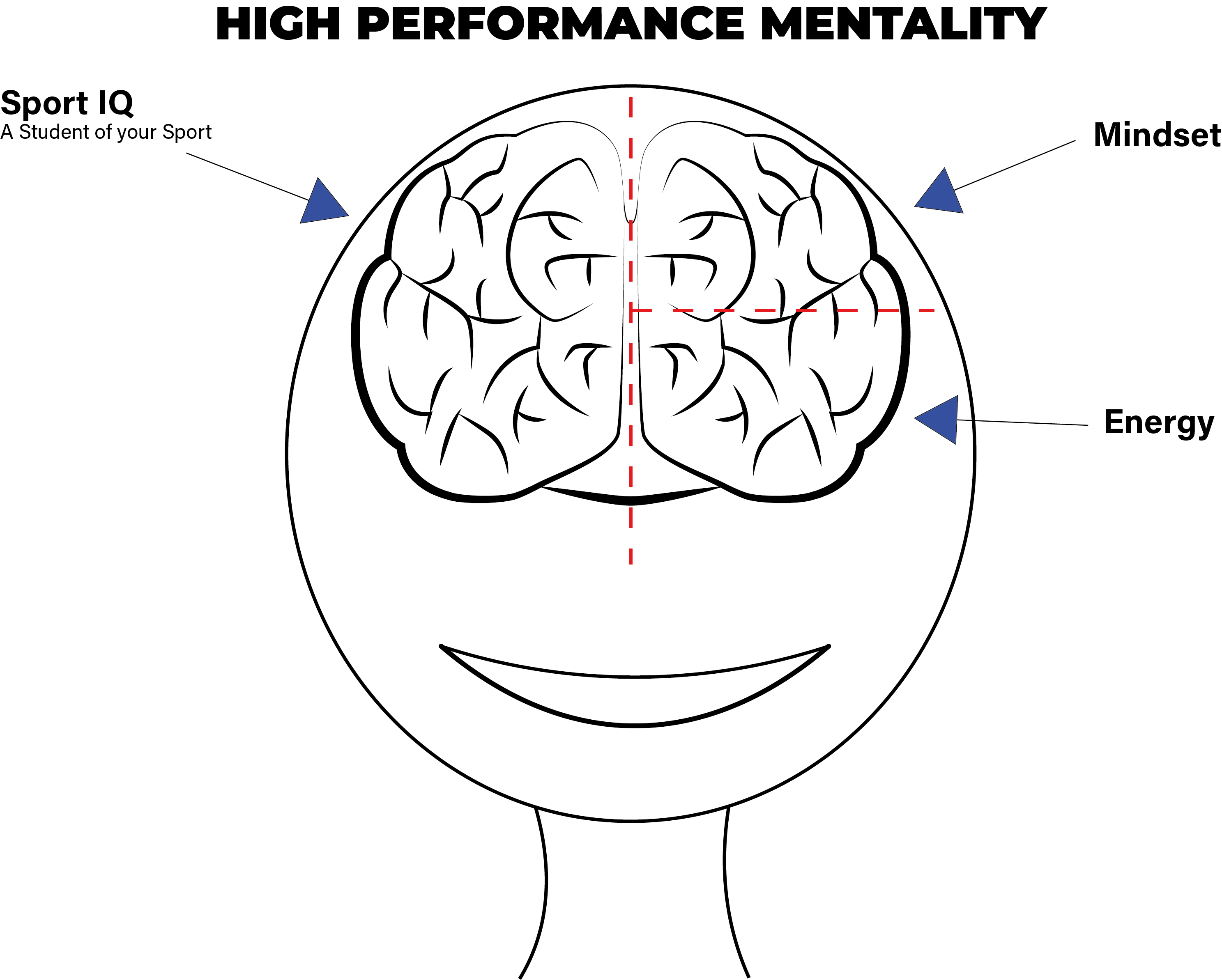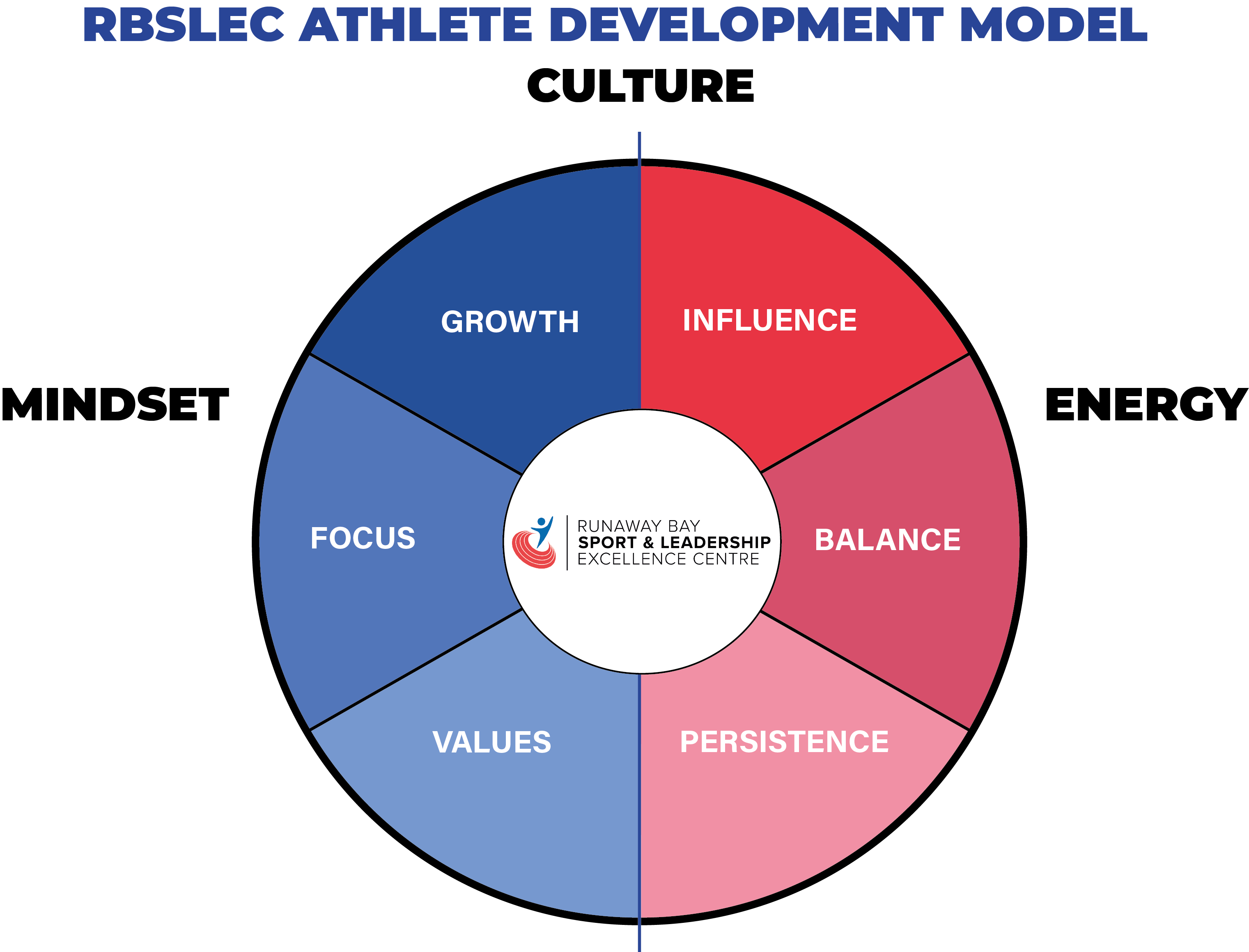The Student Athlete
By the Runaway Bay Sport and Leadership Excellence Centre
The ‘Student Athlete’ domain involves an intricate balance of forces and objectives that require the individual’s attention. It is a busy time that is defined by an individual improving their athletic performance, learning in order to realise their future career aspirations and better understanding themselves as they progress through late adolescent or early adulthood years. Successfully navigating this challenging landscape allows the student to grow as an athlete, a professional and a person.
Further developing the student athlete’s understanding of, and capacity in a number of particularly relevant characteristics will assist them in their journey. These characteristics are grouped under the areas of ‘Mindset’ and ‘Energy’ which make up the ‘ME Student Athlete Development Framework’ at the Runaway Bay Sport and Leadership Excellence Centre.

Mindset
The characteristics that fall beneath ‘Mindset’ are all geared towards positively impacting the student athlete’s internal thought processes. Drawing attention to these areas and developing the student athlete’s understanding of each, will establish their ‘performance mindset’ and ensure that their mind is in the right place to learn as a student, improve as an athlete and grow as a person.
Growth
The first element underneath the ‘Mindset’ half of the athlete development framework is ‘Growth’, which is defined by the student athlete’s willingness to learn. Student athlete’s who have embraced a growth mindset will understand that learning is an ongoing process and an opportunity for improvement, regardless of your level of experience.
Student athlete’s will regularly scan for learning opportunities and seek feedback from a range of knowledgeable sources that can assist with their growth. They will involve themselves in experiences that take them out of their comfort zone, where the chances of failure are high.
Life and elite sport are difficult journeys where setbacks are common and student athletes will benefit from being ‘comfortable’ with this environment. Taking the opportunity to analyse failure and identify areas requiring improvement is pivotal for achieving desired outcomes.
The early adoption of these habits is particularly relevant to student athlete’s as they’re in a developmental phase of their lives and sporting endeavours.
A student athletes progress through the different stages associated with these areas will be defined by ongoing growth and a higher chance at sustained success if they’re able to embed the practices associated with a growth mindset effectively.
Focus
A student athletes’ attention is pulled across a number of different priorities that include study, training, competition and work commitments. To achieve growth and success across all of these different fields, it’s vitally important that the student athlete has developed the ability to focus their attention on what’s in front of them at any one time.
This requires the student athlete to draw all of their awareness to the job at hand. They must be ‘present’ in the moment and keep their mind focused on what’s required of them- then and there.
To make the most of every situation and ensure that it contributes towards ongoing growth, the student athlete must block out physical distractions or distracting thoughts that can take their mind elsewhere. This includes thinking ahead and ‘what if’ thoughts that can be troublesome and impede performance.
While it’s important to develop a student athlete’s ability to ‘switch on’ and focus, it’s also important to develop their ability to ‘switch off’ and relax to give themselves a chance to recharge.
Values
Values make up an important internal framework that guides the student athletes’ thinking and how they process information. Each value offers a lens for reviewing information and collectively they determine how data is categorised before delivering an appropriate action or response that aligns with the individual values framework.
For this system to work effectively and support the student athlete’s growth and success, it is important that they’ve clearly identified the individual values that hold meaning for them. If the student athlete has bought into a process of establishing clarity in their mind around a strong list of values, these will remain front-of-mind to ensure their response to different scenarios is consistent with this internal framework.
Energy
The ‘Mindset’ establishes the foundations for the student athlete’s ‘Energy’ which relates to their output. This includes their Actions, Behaviours and Communications (ABC’s) that formulate the student athlete’s observable demeanour. These characteristics have the potential to positively (or negatively) impact the student athlete’s performance and growth, while also ‘lifting up’ (or subtracting from) the performance of those around them.
Influence
It is important that the student athlete is aware that their actions, behaviours and communications (ABC’s) all possess the power to positively or negatively influence those around them. These outputs convey implicit or explicit messages which collectively define how others view the student athlete. These ABC’s are pivotal for establishing the standards and norms in the environments that the student athlete is engaged in, which can potentially influence how others in those environments act, behave and communicate.
This dynamic is particularly important in a sporting context where individuals are operating in team settings. The standards and norms which all members of the team are contributing towards can have a profound impact on the success and development of the team, and therefore the achievements and growth of the individuals that are a part of the team.
If the individual output of the members of a team is overwhelmingly positive in nature, the environment will be positioned favourably to positively influence each individual to ensure they are getting the most out of their engagement with that team. These influences can add value to the team setting by being sources of great motivation and inspiration. Meanwhile, the reverse effect is a possibility if negative traits become consistently present in individual(s) ABC’s.
Balance
The landscape that the student athlete operates in is an incredibly busy space that requires significant levels of commitment and sacrifice. In addition to study responsibilities, the student athlete has taken on the added workload associated with developing their talents in their chosen sport. When included with employment commitments (which are often required) and the important time spent with family and friends, there are a lot of responsibilities that the student athlete has to dedicate time towards.
To do this effectively, it is important that the student athlete’s output reflects a balanced approach that allocates adequate amounts of time to each endeavour. Overloading in one area often means that another space is neglected which will usually leads to compromised learning and poor outcomes. It can also result in the student athlete feeling ‘burnt out’ in the area that they are over-committing themselves, which will also impact their ability to grow and achieve in that field.
As such, a strategic approach to time management and effectively balancing output across all areas is required to ensure the student athlete has adequate amounts of energy to continue to develop themselves and achieve their goals.
Persistence
Sport and life is populated with setbacks, failures and situations that don’t go to plan. The competitive nature of sport means that athletes must learn how to deal with experiences such as poor individual performances, losses and injuries. Furthermore, athletes are consistently put under pressure and into challenging situations to learn and grow while ensuring they’re able to effectively compete in the difficult environments that define elite sport. As such, the student athlete must develop their ability to be persistent to ensure they’re able to continue to make progress and maintain a positive outlook in the face of these hurdles.
The student athlete needs to embrace failures and setbacks as obstacles and challenges that are part of their journey, as opposed to a definitive outcome. Then embedding persistent habits involves meeting these situations with an analysis that identifies areas for improvement before devising strategies that aim to deliver the required adjustments to achieve success. An effective student athlete will accept difficult circumstances as part of life, learn from the experiences and implement change to develop and grow.

The Runaway Bay Sport and Leadership Excellence Centre (RBSLEC) is an outdoor education centre, owned by the Department of Education. Camps utilise the world-class Gold Coast Performance Centre venue, the Runaway Bay Sport precinct and the nearby Broadwater to deliver Sport and Leadership Development programs to students in Years 3 to 12 that are aligned to the Australia Curriculum.

